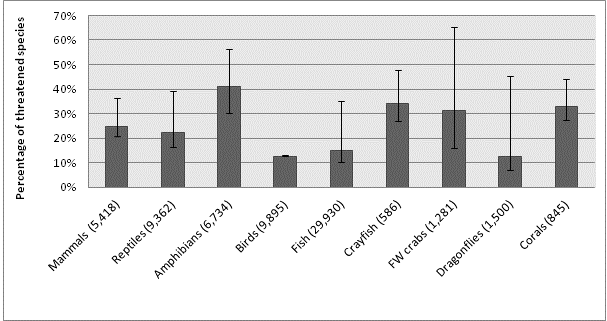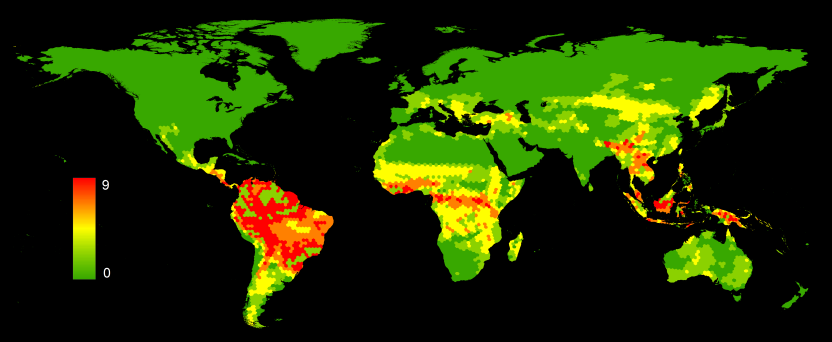It is probably time that I introduce my PhD project, and explain my interest/obsession on Data Deficient and poorly-known species. I am mostly writing this for my family and friends, who are continually confused about my professional endeavours!
In light of rapid global change, the 12th target of the Strategic Plan of the Convention on Biological Diversity states that by “2020 the extinction of known threatened species has been prevented and their conservation status, particularly of those most in decline, has been improved and sustained”. The IUCN Red List of Threatened Species is the foremost inventory for classifying species extinction risk at a global scale, and is key to monitoring progress towards this target. However, 1 in 6 of the 65,000+ species assessed by the IUCN are listed as Data Deficient due to lack of information on their taxonomy, geographic distribution, population status and/or threat processes. Data Deficient species are of great conservation concern as they contribute to considerable uncertainty in estimates of threat (Figure 1). Additionally, genuinely threatened Data Deficient species may be neglected by conservation programmes due to their uncertain extinction risk status.
My PhD focuses on the effect of Data Deficient species on global conservation prioritization. Do data gaps influence perceived patterns of extinction risk, and if so, how can we reduce this uncertainty cost-effectively?

Invertebrates in particular show very high levels of data deficiency, with 35% of dragonflies, 49% of freshwater crabs and 21% of crayfish listed as Data Deficient. The first chapter of my thesis (Bland et al. 2012) concentrated on the effects of data uncertainty on patterns of threat using crayfish, freshwater crabs and dragonflies as model taxa. I showed that in freshwater invertebrates, data uncertainty considerably affects patterns of threat at continental scales. I also concluded that given the current levels of data uncertainty, the relative importance of biological characteristics and threatening processes in driving extinctions in freshwater invertebrates could not be determined. Finally, I recommended that Data Deficient species should be given high research priority to determine their true conservation status.

In the second chapter of my thesis (Bland et al. in prep), I predicted the likely conservation status of Data Deficient mammals. Mammals are well-studied and exhibit a fairly low prevalence of data deficiency (15%), hence provide a good starting point for developing predictive models of extinction risk (Figure 2). I compared the ability of seven Machine Learning algorithms to determine the threat status of data-sufficient species using taxonomic, life-history, geographical and anthropogenic threat information. Machine Learning tools showed very high ability to correctly identify threatened species (up to 94%), and ability to correctly identify geographical centres of threatened species richness. Applying this model to Data Deficient species, I predicted 313 out of 493 Data Deficient species (64%) to be at risk, increasing the estimated proportion of threatened terrestrial mammals from 22% to 27% globally. I found that regions predicted to contain large numbers of threatened Data Deficient species were already conservation priorities, but showed considerably higher levels of species imperilment than previously recognized. I concluded that unless directly targeted for monitoring and conservation, species classified as Data Deficient were likely to slide towards extinction unnoticed.

Given the limited financial resources available for conservation, data should be collected in the most cost-efficient way to inform conservation decisions. My current work focuses on incorporating economic considerations into the prioritization of Data Deficient species. I estimated that monitoring and re-assessing all 10,673 Data Deficient species according to IUCN criteria would cost a minimum of USD 150 million. Predicting extinction risk from species traits and geographical information could provide a cost-effective approach for reducing uncertainty in global risk estimates. Models could also enable the systematic prioritization of species for monitoring according to predicted extinction risk, evolutionary diversity, and cost of monitoring.
Finally, my broader research interests include the interaction between human knowledge, species traits and threatening processes. I am particularly interested in patterns of species discoveries, rediscoveries and extinctions. Areas containing Data Deficient species have been shown to contain more recently described species than expected by chance, suggesting that these sites are indicative of spatial knowledge deficiency and might hold many undiscovered species. Accounting for Data Deficient species could help direct biodiversity inventories, and enable the incorporation of the world’s poorly-known and undiscovered species into conservation planning.
Bland LM, Collen B, Orme CDL, Bielby J (2012) Data uncertainty and the selectivity of extinction risk in freshwater invertebrates. Diversity and Distributions 18(12) 1211-1220
Great post Lucie! Your 94% classification accuracy for threat status is impressive – who needs expert panels!? Is that value reporting the proportion correctly assigned?
Accuracy was 92% and sensitivity (percentage of threatened species correctly identified) 94% on independent data. If we want to understand extinction risk at a coarse scale (threatened vs. non-threatened, rather than individual Red List categories), then predictive models work pretty well!
That’s amazing. I guess I should take back my statement though: threatened species expert groups do more than simply assign threat status. Do you reckon your statistical methods could accurately estimate more management-relevant information too? E.g., primary threats, current population size, and so on?
I don’t think the models could estimate that. Martina Di Fonzo at UQ did her PhD on identifying threats from population trend series – that is probably one of the only ways of ‘remotely’ assessing threats. Experts are still useful because they provide supporting documentation for their assessment, which directs management actions and are also a good way to sum up information available across thousands of species. My models could be used to forecast extinction risk though, incorporating future human population growth or land use change.